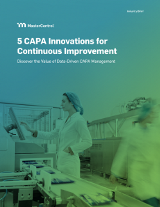
GxP Lifeline
Why Choose a Configurable Quality Event Management Solution?
According to Matt Lowe, Chief Strategy Officer for MasterControl, the technology landscape is changing the work of quality professionals, whether they are familiar with new technologies or not. And it will look dramatically different in as little as five years.
“They’ve got to know about data, how to ingest it, how to manipulate it, how to analyze it, in mass quantities, using technology,” Lowe said. “If we don’t see that coming out in the new quality professionals of our day, we’re going to get left behind.”1
Without requiring a high level of proficiency in data analysis from a quality professional, configurable quality event management (QEM) software makes this possible. That’s not to say that quality professionals are unskilled in analysis. Statistical skill sets are integral to quality management. Rather, quality professionals can now leverage technology to do more of the heavy lifting for them – to capture, manage, and report on data related to their own contexts, directly within their digital quality management solutions in real time.
Challenges Quality Professionals Face With Static Quality Event Software Solutions
Timing, the accuracy and completeness of data, and the ability to adequately resource unplanned events are all major concerns for quality managers. Effective quality event management requires precision and responsiveness. However, quality professionals are often limited in their ability to efficiently solve quality event problems by the tools they use, even digital ones. Because the processes the quality professional must follow are deeply encoded within static interfaces, the agility that their quality management system (QMS) can offer them is often lacking. In fact:
- 20% of quality organizations confirm that existing processes are too rigid and/or complex.
- 22% of quality organizations point to limited quality system and/or process data visibility as a very significant pain point.2
What Can Configurability Look Like in Quality Event Management
With the advent and increasing popularity of low-code/no-code (LC/NC) solutions, skilled business developers or “citizen developers,” as they’re often called, are now able to innovate and improve business processes without the need for additional support from professional developers or vendors and the inherent delays that go with it. In this new paradigm, it is possible to bring total control over quality event management processes back into the hands of the quality professional and keep it within the quality department. This is good news for quality control.
Measurable advantages of using a configurable solution purpose-built for quality event management include:
- Flexible and customized solutions that don’t require custom code.
- Dynamic and data-driven processes.
- Quick, agile, and iterative improvement cycles.
- Accessible, user-friendly interfaces and personalized, targeted workflows
- Closed-loop, cross-functional, cross-process quality event management.
- Automated updates and verifiable regulatory compliance.
- Faster time-to-value with less development time and simplified processes.
What Are Quality Professionals Saying About ConfigurableQuality Event Management Software?
One of the exciting advancements with configurable quality event management is the ability to automate and set up conditional routing for workflows and form completion. Workflows are based on rules and logic that are unique to the quality organization that establishes them. According to Matthew Seitz-Paquette, North America Quality Specialist for Fagron, dynamic process design capabilities offer a very promising way to support the international pharmaceutical compounding company’s unique quality event management needs and contexts, which include long forms, differentiated user roles, and multiple sites.
“It gives us the ability to be dynamic,” noted Seitz-Paquette. “Right now, we have a form with multiple different sections and over 150 questions. The sections and questions don’t apply to every scenario, but they are always visible, and our end users have to see it all. … I could make a dynamic form. This section applies. This doesn't. If it doesn't apply, then the section will be hidden. If it does, the questions in the section can be required. I can improve my efficiency and data just by the design of the form.”
Conditional workflow routing is also stirring up excitement for quality professionals at BioBridge Global. The regenerative medicine pioneer has found that personalizing their quality event software with user-specific processes will help end users complete their work more quickly. Users will only see what they need to see so they won’t get overwhelmed and bogged down with unnecessary steps or details.
Glenn Porritt, senior eQuality system analyst for BioBridge Global, shared his recent experience working with configurable quality event software: “I love that I’ve been able to create a form that is basically ready to go as soon as it is officially launched. I love the way I can control the routing of the form based on what has been entered. And creating that routing is very user-friendly. When I click on the icon to add routing, a pop-up just shows all my options and it’s great.”
Conclusion
While code-intensive solutions tend to enlarge the gap between quality professionals and the tools they use, LC/NC solutions tend to close it. The configurable approach to quality event management aligns well with Quality 4.0 initiatives, including continuous improvement and flexibility in quality processes that are data-driven. Quality processes can evolve right alongside the quality professionals who design them. It will be exciting to watch the unlimited potential of both unfold together and see where it takes us next.
References:
1 "Stay In Your Lane: How to Compete In a Saturated Market," by Megan Wallin-Kerth, Quality Digest, March 27, 2023.
2 "The State of Digital Quality Maturity in Pharma and Medtech," research report, MasterControl.

